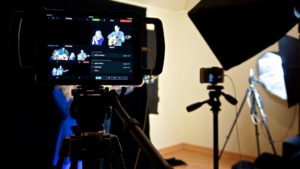My first exposure to a multi-camera live broadcast event was in an earlier career when the local TV station set up for a broadcast in the theater I worked for. There were two trucks in the alley way. Cables running everywhere, and two days to set up. Running it all was a team of 12 people.
Yesterday, we did a three camera live broadcast and I carried the broadcast gear in my shoulder bag and was set up in an hour.
That’s a pretty serious change!
Back in the days of The DV Guys, we were among the pioneers of live streaming with a weekly radio show. Even that was complex and expensive, but at least we didn’t need a broadcast license! Add in picture and another rack of switching and synchronizing gear was needed.
But fast forward to today. We have broadcast level gear with switchers from Blackmagic for relatively little money. But as affordable as the ATEM switchers are, there’s still a lot of infrastructure (and cost) related to doing a multi-camera live broadcast.
Looking to make sure I had all the bases covered for an event my singing teach – April Lindsay – I reached out to my network and my friend Kevin Bourke suggested SwitcherStudio. Yes, it’s limited to iOS devices, but we had enough of those available, and the $25 for a one month subscription seemed like a good budget.

Mounted on a sturdy tripod and held in an iOgrapher frame (the brainchild of another friend) the Switcher interface is easy to follow and very powerful. Another two iPhones on available tripods completed our studio setup.
Lower Third graphics were prepared in advance and a roll-in video loaded ready to add to the Switcher for going live. There’s a small, but useful collection of transitions and a couple of varieties of picture-in-picture, which we didn’t use on this show. Remote control of camera zoom, exposure and balance was essential with well lit talent on black drapes.
Oliver Sandino and I shared the Switcher duties – I was on stage for two songs – over the 3 hour event. Switcher proved up to the task.
When we were done, we were packed and out the door in 10 minutes from the end of the live show.
There are features we didn’t explore, like Director mode that would get you all original angles as a FCP X multicam clip, or the ability to share desktop screens to the live shoot from macOS.
The last time I produced and directed a live multi-camera show (for just internal use, no broadcasting) it was a one day setup and several hours before we got to go home. There was a lot more gear than would fit in a shoulder bag too! Â I can guarantee the heaviest items then were not a power extension cord and a couple XLR cables!
What a wonderful time to be alive!
2 replies on “Multicamera Broadcasting: Then and Now”
Awesome writeup! Isnt it nice to have no cables? 🙂
Here’s a product line that will be used at the Aspen Ideas Festival this year for live streaming interviews: https://www.epiphan.com/products/
They will be using the Pearl-2 hooked up to 2 broadcast cameras but the Lumio robo-camera, https://www.epiphan.com/products/lumio12x/ is pretty compelling for relatively static discussions. This 3 camera set-up might need a slightly larger shoulder bag but it’s still a long way from the trucks I used to live in.
For AIF, I will be in a different venue with a traditional 3-camera fly-pack but I’m interesting in checking this out.